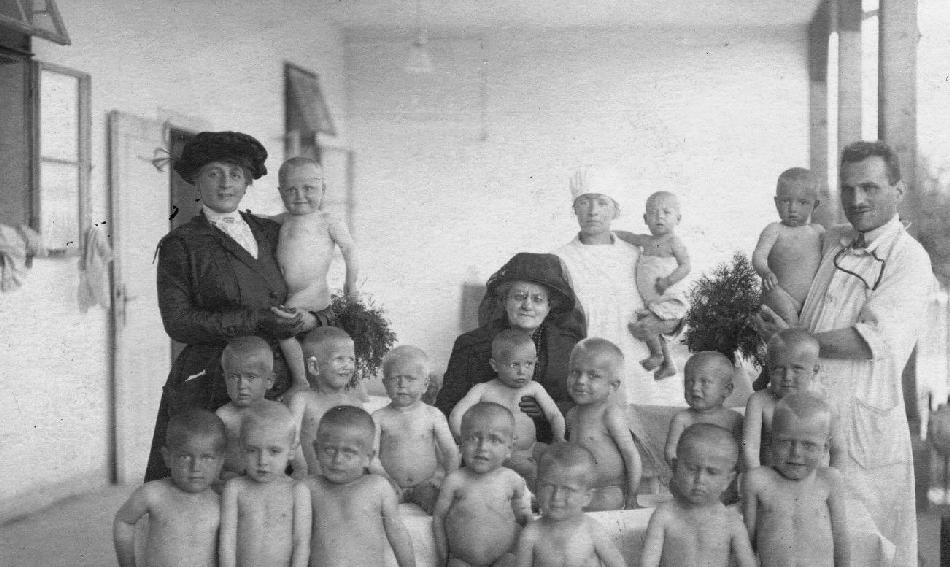
American World War I Relief Efforts: Austria--American Vienna Children's Clinic

Figure 1.--Here Vienna children are being treated at the American Clinic. The caption on the back reads, "Ricketty children at the American Convalescent Home for Vienna Children, Aiu Tiooli." According to the spomsor, tuberculous was an even bigger problem.
|
|
American aid to Austria was not limited to food. The Unitted States provided oher relieft supplies. We also notice medical assistance. We have not been able to find much information about this effort. We do notice the American Clinic in Vienna which treated children with rickits. Children during and after World War I were the most vulnerable to food shortages and malnutrition. One of the many possible health problems is rickits. This is the softening and weakening of bones in children commonly caused by an extreme and prolonged vitamin D deficiency. Vitamin D is needed to absorb calcium and phosphorus from the gastrointestinal tract. A vitamin D deficiency means that it is difficult to maintain proper calcium and phosphorus levels in bones, which pf course is disaterous for growing young children. An American clinic was set up in Vienna after the War to treat badly undrnourished children. One of the major problems was rickets. It was supported by the American Clothing and Hopital Relief for Vienna organized in New York City (December 1919). New York residents of Austrian escent were the major supporters. The purpose was to raise fund for relief work in Vienna. The Clinic was one of its major efforts. The group began by sending food and clothing. At the time information on the situation in Vienna was limited. They managed to establish conduct with the the main welfare agency in Vienna, the Kinder-Woblfartwerk of Vienna (KWV), describing a despeate need for funds to care for tuberculous (TB) children. The KWV reported that 97 percent of the children in Viennaere undernourished and some 90 percent of them were affected by TB. Some 50,000 undernourished but otherwise healtly children were being sent abroad, but counties willing i care for hungry children were not willing o accept children who had contracted TB. Thus there was a pressing need to set up care facilities in Vienna. [ACHRV]
Sources
The American Clohing and Hospital Relief for Veinna (ACHRV). "Report on the American Convalescent Home for Vienna's Children".
HBC

Navigate the Boys' Historical Clothing Web Site:
[Return to the American World War I Austrian food relief effort]
[Return to the American World War I food relief effort]
[Return to the Main World War I German Home Front Page]
[Return to the Main World War I German Economic Page]
[Return to the Main World War I rationing page]
[Aftermath]
[Alliances]
[Animals]
[Armistace]
[Biographies]
[Causes]
[Campaigns]
[Casualties]
[Children]
[Countries]
[Declaration of war]
[Deciding factors]
-------[Diplomacy]
[Economics]
-------[Geo-political crisis]
[Home front]
[Intelligence]
[Military forces]
[Neutrality]
[Pacifism]
[People]
[Peace treaties]
[Propaganda]
[POWs]
[Russian Revolution]
[Terrorism]
[Trench warfare]
------[Technology]
[Weaponry]
[Bibliographies]
[Contributions]
[FAQs]
[Images]
[Links]
[Registration]
[Tools]
[Return to Main World War I page]
[Return to Main war essay page]
[Return to CIH Home page]
Navigate the Historic Boys' Clothing Web chronological pages:
[The 1840s]
[The 1900s]
[The 1930s]
[The 1940s]
[The 1950s]
[The 1960s]
[The 1970s]
[The 1980s]
[The 1990s]
Created: 8:46 AM 7/10/2017
Last updated: 8:46 AM 7/10/2017



